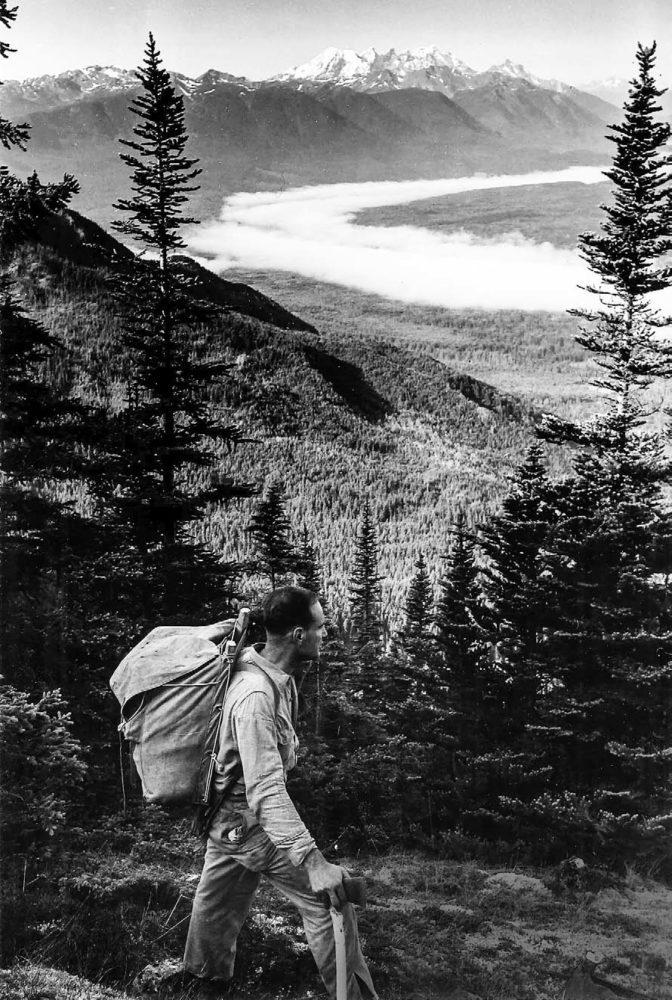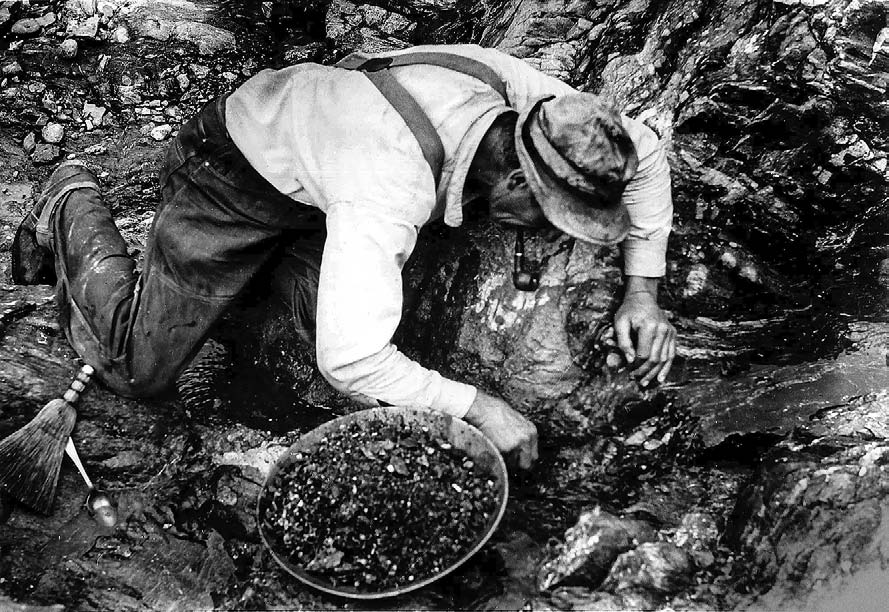
When the Collins Overland Telegraph crews came through the Bulkley Valley in 1866, attempting to build a telegraph line to Siberia, they had just come up through the Cariboo country. The great Cariboo Gold Rush was winding down but there was still lingering excitement in the air. At least some members of the construction party of more than 100 men probably carried gold pans, tested the creeks and watched for interesting rocks. But they would have been disappointed because very little gold is carried by streams flowing into the Bulkley River, and occurrences of potentially economic minerals are rare close to the old telegraph right-of-way. But the telegraph line connected with the Cariboo Road at Quesnel and provided improved access for future prospectors.
In the late 1800s, a few prospectors began exploring seriously for minerals in the Bulkley Valley and adjacent mountains, and by then they were more focused on rocks than on gold in sand and gravel. Some were heading for the Yukon goldfields but decided they had come far enough, while others came to the area after working on the new Dominion government telegraph line to the Yukon. By around 1905 to 1907, the area was overrun with prospectors, as it became clear that the Grand Trunk Pacific Railway Company would construct a line through the district.
These were exciting times for prospectors and would-be miners, as they explored this geologically unknown country with its apparently endless mineral possibilities. There was a general assumption, reinforced by continuing discoveries of small veins containing copper, lead, zinc, silver and gold, that there were large and rich ore deposits to be found. As British journalist F.A. Talbot put it in 1911, the area offered “a first-rate sporting chance” of hosting economic mineral deposits.

Hazelton, served by sternwheel steamboats on the Skeena River from 1891 until the completion of the railroad to New Hazelton in 1912, was the administrative and main supply centre in the early years and many prospectors were based there. When a couple of saloon-hotels and a store were opened at Aldermere about 1904, and Telkwa was founded in 1907, some settled in that general area. A few started small farms and went prospecting after haying was over – there was a good demand for horse hay in those days, when pack trains were still the main carriers of supplies. Smithers was founded in 1913, when the railway arrived in the Bulkley Valley.
The prospectors were not entirely on their own because some technical and other assistance was provided by the federal and provincial governments.

The Provincial Mineralogist, Fleet Robertson, came through the valley on horseback in 1905, assessing the potential of coal prospects on and near the Telkwa River and of mineral claims in the Telkwa and Babine mountains and near Hudson Bay Mountain. He gathered valuable geological, agricultural, historical and climatic information about the region at a time when there was “neither waggon nor waggon road between Hazelton and Quesnel,” as he wrote.
W.W. Leach, of the Geological Survey of Canada, spent much of the summers of 1906 to 1908 in the Bulkley Valley. There was a lot of mineral exploration activity in the Telkwa Range bybody: then, and there were many new copper discoveries. Leach drafted a detailed contour map in 1906 showing the general geology of the Telkwa River area and he studied the newly discovered prospects.

More technical help arrived in 1917, when the B.C. Mineral Survey appointed Jack Galloway as resident engineer, based in Hazelton. Galloway devoted several years to advising prospectors and visiting their prospects.
Numerous mineral occurrences were found by the first explorers in the Bulkley Valley area, and many prospects on Hudson Bay Mountain and in the Babine and Telkwa mountains shipped a few tons of ore, mostly by packhorse. However, only the Duthie, Cronin and – eventually – Dome Mountain mines achieved notable production, as did the coal mine at Telkwa.

Prospecting declined during the Great Depression, but picked up somewhat during the Second World War when tungsten, mercury and other metals were in short supply. There was a general increase in prospecting following the war, reaching a peak in the 1960s during the Great Copper Rush. Leading the exploration charge were large companies with helicopter-supported teams of specialists using geochemistry and other relatively new techniques and assisted by continuing government mapping programs. Most of these companies used Smithers as a base. Important mines that were discovered in this general area during that period were Bell Copper (Noranda) at Babine Lake; Equity Silver (Kennco) southeast of Houston; and Huckleberry (Kennco) southwest of Houston. The Granisle mine was developed during this time but it had been discovered prior to 1912. The Huckleberry mine is currently producing copper, gold, silver and molybdenum. Mining stopped at both Bell and Granisle before the deposits were completely mined out. One or both may produce copper and other metals again.

As it turned out, the big mines (except for Granisle on Babine Lake) eluded the first prospectors, although there was a large molybdenum deposit almost beneath their feet. Nearly all the mineral showings they were working on around Hudson Bay Mountain, including the Duthie mine, were part of a single mineralizing system centred on what is now known as the Davidson deposit, most of which is hidden within the mountain. It was not until the early 1960s, when molybdenum occurrences on the mountain attracted the attention of Stew Wallace (Climax Molybdenum Company) and work continued on key claims optioned from local prospectors Bill Yorke-Hardy, Eddie Malkow, Hunter Simpson and Russ McFarland, that the significance of the deposit was recognized and the geological picture started falling into place. A major molybdenum resource has now been outlined at the Davidson deposit, only about eight kilometres northwest of the town of Smithers.
